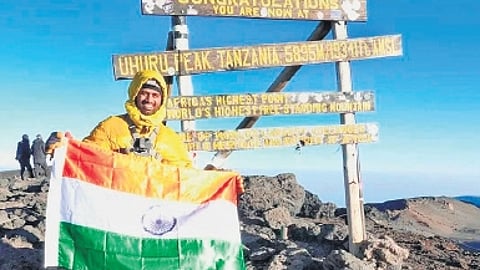

HYDERABAD: Sunith Kumar, a self-taught mountaineer, relies on his passion for reading to educate himself about training and planning difficult climbs like Kilimanjaro and Aconcagua.
Could you share a bit about your background?
I began trekking around 2013 during my first job. The inspiration to start trekking struck me after recovering from tuberculosis, a condition that had kept me hospitalised for a couple of months. One day, my best friend proposed a trip to the Himalayas, a place I had little knowledge of at the time. Intrigued and with a “why not?” attitude, I decided to join him. This was a significant moment as I had never travelled beyond Hyderabad before. This adventure was a turning point, leading to a series of treks over the past ten years. Gradually, I set my sights on more challenging summits and my current pursuit of conquering the Seven Summits.
How do you prepare for challenging climbs?
The journey took time and effort. Mental toughness gained during my battle with tuberculosis was my initial asset. Yet, I soon realised that physical fitness is also important; of course, it is a combination of both. This prompted me to incorporate regular gym workouts into my routine. Once I kept going higher up the mountains, it was clear that I needed a more organised plan and I needed a lot more than just the gym. It meant sacrificing, my favourite food and aligning my life around the training that I have to do.
Could you delve into the specifics of your preparation?
Aconcagua, standing at 22,300 feet in the Andes, poses challenges primarily related to altitude and distance. The equipment required includes double boots, crampons, down jackets, and pants to withstand temperatures ranging from -20 to -45 degrees Celsius. Technical gear like ice axes, trekking poles, and ample snacks are essential. The 18-day journey spans approximately 70 kilometres (up and down the mountain).
How does your diet change during these climbs?
On the climb, logistical services manage the food supply, focusing on vegetarian options for me. Maintaining an intake of around 2,600 calories per day is crucial. Initially cooking for myself, I later employed a meal service to streamline my diet while juggling work responsibilities.
Managing both work and climbing must be challenging. How do you strike a balance?
Balancing a demanding job as a delivery program manager with climbing preparations involves meticulous scheduling. Daily routines include two to four hours of workouts, with occasional rest days. Early mornings, fueled by coffee, and strategic planning help me navigate the challenges of both worlds.
How do you prepare yourself mentally?
While not a regular yoga practitioner, I engage in visualisation exercises. I visualise being on the mountain and the challenges that I would probably face. Visualising challenges and mentally preparing for the unexpected contributes to about 70% of readiness. This mental fortitude proves invaluable during extended climbs.
Can you share a memorable experience?
Climbing Kilimanjaro was undoubtedly a highlight, but the people I’ve encountered along the way, diverse in age and culture, have left a lasting impact. The connections forged through a shared love for mountains make these experiences truly memorable. I have always believed that mountains let you climb them, you don’t climb the mountains.
How does your family support your climbing endeavours?
Initially hesitant due to the risks associated with climbing, my parents have now become supportive of my passion. They understand the dedication and effort I invest in training, planning, and maintaining a strict lifestyle, aligning with my dream of conquering summits.